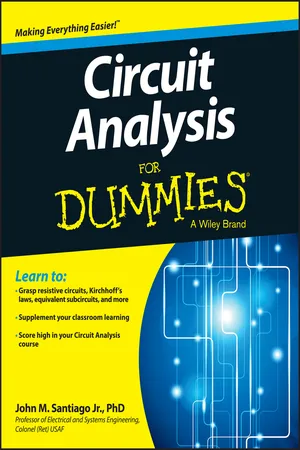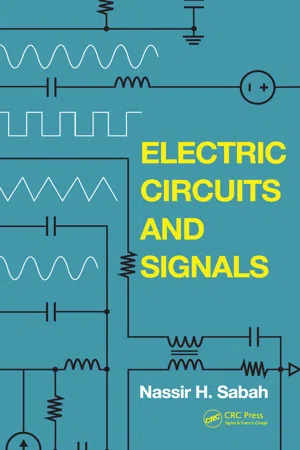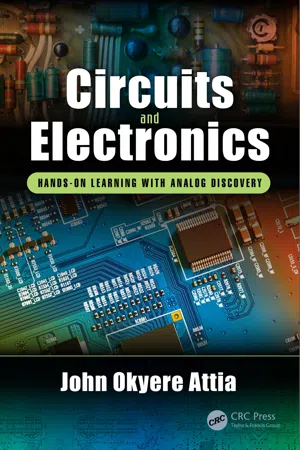Physics
Circuit Analysis
Circuit analysis involves the study of electrical circuits to understand and predict the behavior of electrical currents and voltages within them. It includes techniques such as Kirchhoff's laws, Ohm's law, and network theorems to analyze and solve for circuit parameters like current, voltage, and power. This analysis is essential for designing, troubleshooting, and optimizing electrical circuits.
Written by Perlego with AI-assistance
7 Key excerpts on "Circuit Analysis"
Learn about this page
Index pages curate the most relevant extracts from our library of academic textbooks. They’ve been created using an in-house natural language model (NLM), each adding context and meaning to key research topics.
- eBook - ePub
- John Santiago(Author)
- 2013(Publication Date)
- For Dummies(Publisher)
Part I Getting Started with Circuit AnalysisVisit www.dummies.com to learn more and do more with For Dummies.In this part . . .Discover what Circuit Analysis is all about.Get the scoop on current and voltage behaviors in common circuit components and find out how to read circuit diagrams.Familiarize yourself with Kirchhoff’s voltage law and Kirchhoff’s current law — two laws essential for creating connection equations.Use source transformation and current and voltage divider techniques to simplify Circuit Analysis.Passage contains an image
Chapter 1 Introducing Circuit Analysis In This ChapterUnderstanding current and voltageApplying laws when you connect circuit devicesAnalyzing circuits with algebra and calculusTaking some mathematical shortcutsC ircuit analysis is like the psychoanalysis of the electrical engineering world because it’s all about studying the behavior of circuits. With any circuit, you have an input signal, such as a battery source or an audio signal. What you want to figure out is the circuit’s output — how the circuit responds to a given input.A circuit’s output is either a voltage or a current. You have to analyze the voltages and currents traveling through each element or component in the circuit in order to determine the output, although many times you don’t have to find every voltage and every current within the circuit.Circuit Analysis is challenging because it integrates a variety of topics from your math and physics courses in addition to introducing techniques specific to determining circuit behavior. This chapter gives you an overview of Circuit Analysis and some of the key concepts you need to know before you can begin understanding circuits.Getting Started with Current and VoltageBeing able to analyze circuits requires having a solid understanding of how voltage and current interact within a circuit. Chapter 2 gives you insight into how voltage and current behave in the types of devices normally found in circuits, such as resistors and batteries. That chapter also presents the basic features of circuit diagrams, or schematics. - S. Bobby Rauf(Author)
- 2021(Publication Date)
- River Publishers(Publisher)
Chapter 2 DC Circuit Analysis and Basic Electronic DevicesIntroduction
In this chapter, we will review three fundamental laws of physics and electrical engineering, namely (1) Ohm’s law, (2) Kirchhoff’s voltage law, and (3) Kirchhoff’s current law. These three laws are instrumental in performing basic Circuit Analysis. Laws serve a vital purpose in electrical engineering analysis and problem-solving in DC as well as AC domains. Most engineering problems entail determination of unknown values of key parameters under certain known circumstances or conditions. Laws allow us the opportunity to formulate equations that can be solved for values of unknown parameters. Solving for one unknown variable requires a minimum of one equation, solution for determination of the values of two unknown variables requires two equations, and so on. Therefore, laws afford us the opportunity to model an engineering problem or scenario in the form of set of equations that can be solved to adequately define and idengify unknowns. Similar to the three basic laws of static equilibrium, i.e., ΣFx = 0, ΣFy = 0, and ΣM = 0―laws that a civil or mechanical engineer might employ to solve for unknown forces in a static equilibrium beam or truss scenario ― the Ohm’s law, the Kirchhoff’s voltage law, and the Kirchhoff’s current law are used to solve for important electrical parameters like current, voltage, resistance, power, energy, reactance, impedance, reactance, etc. The latter three parameters are AC entities, discussed in greater detail in Chapter 3.In addition to the basic laws, important electrical circuit principles and circuit simplification techniques, such as voltage division and current division will be discussed and their application will be illustrated through sample problems in this chapter. Note that there are many other principles and methods that are at an electrical engineer’s disposal to solve or analyze complex circuits. For example, the conversion of Y load (or resistor) configuration to Delta- eBook - ePub
- Ray Powell(Author)
- 1995(Publication Date)
- Butterworth-Heinemann(Publisher)
3DC Circuit Analysis
3.1 INTRODUCTION
Circuit Analysis is important in order to be able to design, synthesize and evaluate the performance of electric circuits or networks. The two basic laws for Circuit Analysis are Kirchhoff’s current law (KCL), sometimes referred to as the first law and Kirchhoff’s voltage law (KVL), sometimes called the second law. However, a number of techniques have been developed, in the form of network theorems, for simplifying the analysis in the case of more complicated circuits. These theorems, which are introduced in this chapter, are applicable to linear circuits, both a.c. and d.c, but it is convenient to consider d.c. circuits only to begin with because they are a little simpler mathematically and the concepts are that much easier to grasp.When you have studied this chapter you should be able to calculate the current, voltage and power in any element of most commonly encountered d.c. circuits.3.2 DEFINITION OF TERMS
It will be useful first of all to define terms, and Fig. 3.1 will be used for this purpose. It shows a five-element circuit of which one (the battery or voltage source) is active and the other four (resistors) are passive.Figure 3.1• Node: a point at which two or more elements have a common connection is called a node. Thus there are six nodes in the circuit, numbered 1–6.• Short circuit: the connection between nodes 4 and 5 is made with a piece of wire having virtually no resistance and is called a short circuit. The connection between nodes 5 and 6 is also a short circuit so that nodes 4, 5, and 6 are identical nodes and the circuit may be redrawn as shown in Fig. 3.2 .Figure 3.2In a circuit diagram it would be neater to draw the circuit of Fig. 3.1 .• Open circuit: if the resistor R 1 - eBook - ePub
- W. Bolton(Author)
- 2015(Publication Date)
- Routledge(Publisher)
Chapter 11 Circuit Analysis11.1 Introduction
This chapter is concerned with the analysis of circuits containing just resistors and d.c. sources and follows on from the discussion of such circuits in Chapter 9 . Circuit elements which obey Ohm’s law have a constan t value of resistance R which does not change when the current changes and so the potential difference V across such a resistor is related to the current I through it by V = IR. Also, since the power P = IV, we can write:The fundamental laws used in Circuit Analysis are Kirchhoff’s laws:- Kirchhoff’s current law states that at any junction in an electrical circuit, the current entering it equals the current leaving it.
- Kirchhoff’s voltage law states that around any closed path in a circuit, the sum of the voltage drops across all the components is equal to the sum of the applied voltage rises.
- Circuit reduction techniques for resistors in series and parallel, including the current divider rule and the voltage divider rule.
- Kirchhoff’s laws with node and mesh analysis.
11.2 Series and parallel resistors
Circuit elements are said to be connected in series when each element carries the same current as the others; they are in parallel with one another when the same voltage appears across each of the elements. A series–parallel circuit is one that contains combinations of series- and parallel- connected components. A technique for solving such circuits is to systematically determine the equivalent resistance of series or parallel connected resistors and so reduce the analysis problem to a very simple circuit. This was illustrated in Chapter 9 and this reviews the principles and then extends them to more difficult problems.11.2.1 Resistors in series
For series resistors the equivalent resistance is the sum of the resistances of the separate resistors:equivalent resistance Re = R + R2 - eBook - ePub
- Nassir H. Sabah(Author)
- 2017(Publication Date)
- CRC Press(Publisher)
2Basic Circuit Connections and Laws
Overview
There are two basic circuit laws, known as Kirchhoff’s laws, which are expressions of conservation of charge and conservation of energy. They must be obeyed, therefore, by electric circuits under all conditions, independently of the circuit configuration and the circuit elements involved.Kirchhoff’s laws are first applied in this chapter to analyze some simple circuits, namely, resistive voltage dividers and current dividers. These simple circuits feature the two basic circuit connections: the series and parallel connections. Circuit elements connected in series or in parallel can be combined with other circuit elements in series or in parallel combinations to obtain circuits of any desired complexity. When resistors are connected in series or in parallel, the individual resistances or conductances combine according to some simple rules to give an equivalent resistance or conductance. The concept of equivalence is fundamental to Circuit Analysis and is applied to the Δ-Y transformation and transformation between voltage and current sources.The voltage divider supplying a load at a reduced voltage is considered at the end of the chapter to illustrate a common and important feature of engineering design in general, namely, the trade-off between conflicting performance requirements. The example also illustrates the practical effects of tolerance of resistance values due to inevitable variations in component values during manufacturing. - eBook - ePub
Circuits and Electronics
Hands-on Learning with Analog Discovery
- John Okyere Attia(Author)
- 2017(Publication Date)
- CRC Press(Publisher)
2Basic Circuit Laws and Theorems
INTRODUCTION In this chapter, the basic circuit laws and theorems will be explored by using the Analog Discovery board. The circuit laws and theorems that will be explored include Ohm’s Law, Kirchhoff’s Voltage Law, Kirchhoff’s Current Law, Thevenin’s and Norton’s Theorems. In addition, the linearity principle will be discussed.2.1 Ohm’s Law
Ohm’s Law states that the voltage, v (t ), across a resistor is directly proportional to the current, i (t ), flowing through the resistor. Equation 2.1 shows the Ohm’s Law relationshipv(2.1)( t )= R i( t )where R is the proportionality constantExample 2.1 shows how the Analog Discovery board can be used to verify Ohm’s Law.Example 2.1 Ohm’s LawFor the circuit shown in Figure 2.1 , use the Analog Discovery board to show that the voltage across the resistor is proportional to the current flowing through the resistor. Assume that R = 1.0 kΩ.Solution :Build the Circuit:Use a breadboard to build the circuit shown in Figure 2.1 . Connect AWG1 (yellow wire) to node 1 of the circuit. Also, connect scope channel 1 positive (orange wire) to node 1. In addition, connect the scope channel 1 negative (orange-white wire) to node 0. Moreover, connect the ground (black wire) to node 0 of the circuit.Signal Generation: Click WaveGen in the main WaveForms screen. Go to Basic → dc → Offset (set to 1 V) → Click Run AWG1. Activation of Scope: Click the scope in the main WaveForms screen. Go to Run → Autoset → Measure → Add → Channel 1 Vertical → Maximum → Add Selected Measurement → Close Add Instrument.FIGURE 2.1 Resistive circuit.To add a Mathematic Channel to measure the current, use the following steps: Go to Control → Add Mathematic Channel → Custom → Enter function → C1/1000 → OK.TABLE 2.1 Voltage and Current of a Resistive CircuitTo get the value for the current, go to Measure → Add → Math 1 Vertical → Maximum → Add Selected Measurement → Close Add Instrument. By default, the units in the math channel will be volts. To change the units to amperes, click the Setting button → select Units → select A from the drop-down menu. - Patrick F. Dunn(Author)
- 2019(Publication Date)
- CRC Press(Publisher)
loop is a closed path that goes from one node in a circuit returning to itself without passing through any intermediate node more than once. Any consistent sign convention will work when applying Kirchhoff’s laws to a circuit. Armed with this information, some important DC circuits can be examined now.3.5 Elementary DC Circuit Analysis
In DC circuits, current is steady in time. Thus, inductance does not need to be considered. An inductor, however, has resistance. This typically is on the order of 10 Ω. Usually in a DC circuit, because an inductor’s resistance is small as compared to the resistances of other components in the circuit, the inductor’s resistance is neglected.FIGURE 3.8 The voltage divider.3.5.1 Voltage Divider
The first elementary DC circuit is the voltage divider . This simple circuit is comprised of two resistors,RsandRf, in series between a voltage source,Vs, and electrical ground as shown in Figure 3.8 . Application of Ohm’s law and Kirchhoff’s second law show that the output voltage,Vo, measured between the junction of the two resistors and electrical ground is(3.17)V o=V s[R f/ (R f+R s) ] .One application of the voltage divider is to produce a desired output voltage from a known source voltage by choosing specific values of the resistances. For example, ifVs= 5 V andRfis chosen to be equal toRs, thenVo= 2.5 V. Another typical application is to use the voltage divider to convert a sensor’s output resistance to a voltage. This would be the case for resistive sensors, such as a strain gage, thermistor, or photocell. Here,VsandRfare chosen and fixed. Then,Vois related toRsthrough Equation 3.17 . Note that whenRsincreases,Vodecreases.FIGURE 3.9 A battery and electric motor circuit.3.5.2 Electric Motor with Battery
The second elementary DC circuit to analyze is that of a DC electric motor in series with a battery, as shown in Figure 3.9 . Examine the battery first. It has an internal resistance,Rbatt, and an open-circuit voltage (potential difference),Voc.Rbattis the resistance andVocthe potential difference that would be measured across the terminals of the battery if it were not connected to the circuit. However, when the battery is placed in the circuit and the circuit switch is closed such that current,Ia, flows in the circuit, the situation changes. The measured potential difference across the battery now is less because current flows through the battery, effectively leading to a potential difference acrossRbatt






